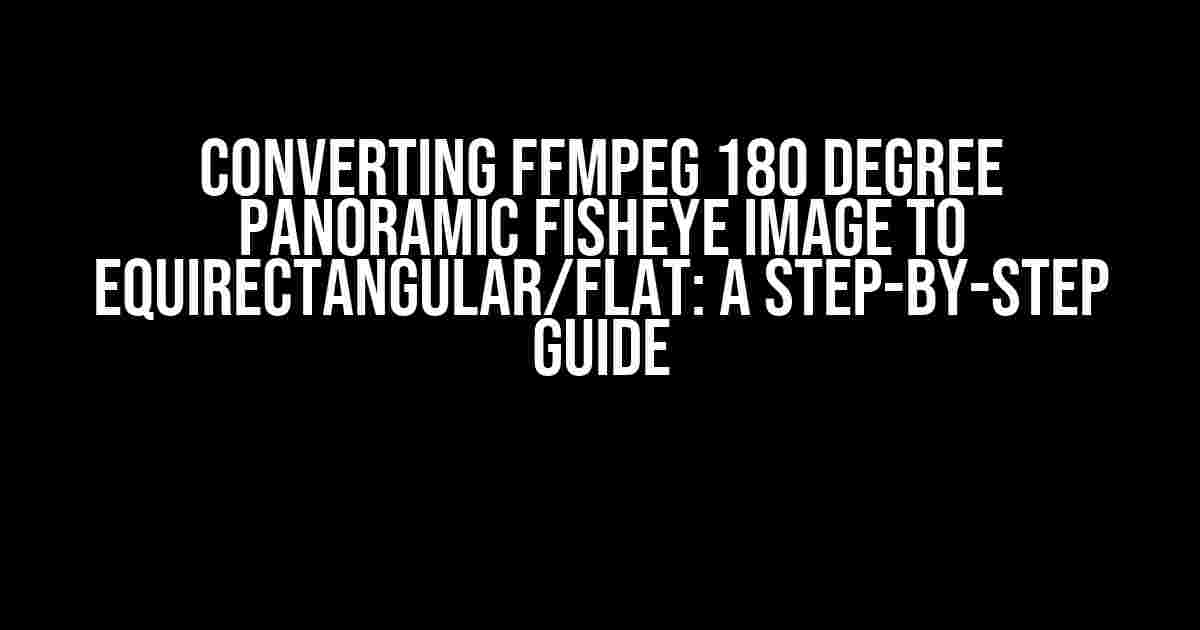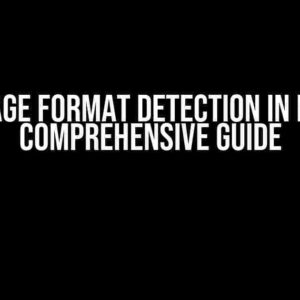Are you tired of dealing with distorted fisheye images? Do you want to unlock the full potential of your 180-degree panoramic camera? Look no further! In this article, we’ll take you on a journey to convert your fisheye image to a stunning equirectangular or flat format using FFmpeg, the swiss army knife of video and image processing.
What is a Fisheye Image?
A fisheye image is a type of panoramic image that is captured using a specialized lens or camera. It has a distinct curvature, giving it a characteristic “fisheye” appearance. While fisheye images can be aesthetically pleasing, they often suffer from severe distortion, making them less suitable for certain applications.
The Problem with Fisheye Images
- Distorted perspective: Fisheye images have a heavily curved horizon, making it difficult to perceive the actual shape and size of objects.
- Limited usability: Fisheye images are not compatible with most image editing software, making it challenging to perform tasks like object tracking or textoverlay.
- Poor compatibility: Fisheye images are often not supported by social media platforms, online forums, or blog platforms, limiting their sharing and publishing potential.
What is Equirectangular Format?
Equirectangular format, also known as equiangular or equirect, is a type of panoramic image that has a 2:1 aspect ratio. It’s a cylindrical projection that maps a 360-degree scene onto a flat image, making it ideal for virtual tours, 360-degree video, and other immersive experiences.
Benefits of Equirectangular Format
- Accurate representation: Equirectangular format preserves the original shape and size of objects, providing an accurate representation of the scene.
- Improved usability: Equirectangular images are compatible with most image editing software, making it easy to perform tasks like object tracking, text overlay, or color grading.
- Widespread support: Equirectangular images are widely supported by social media platforms, online forums, and blog platforms, making them easy to share and publish.
Converting Fisheye to Equirectangular using FFmpeg
FFmpeg is a powerful, open-source software that can convert your fisheye image to equirectangular format. Here’s a step-by-step guide to get you started:
Prerequisites
- FFmpeg installed on your system (download from ffmpeg.org)
- Fisheye image in a compatible format (e.g., JPEG, PNG, TIFF)
- Basic knowledge of command-line interfaces (CLI)
The Conversion Process
To convert your fisheye image to equirectangular format, you’ll need to use the following FFmpeg command:
ffmpeg -i input_fisheye.jpg -vf vflip,fisheye_ correction,eqr output_equirectangular.jpg
Let’s break down the command:
-i input_fisheye.jpg: Specify the input fisheye image file-vf: Enable video filters (in this case, we’re applying multiple filters)vflip: Flip the image vertically (optional, but recommended for most fisheye images)fisheye_correction: Apply fisheye correction to undistort the imageeqr: Convert the image to equirectangular formatoutput_equirectangular.jpg: Specify the output equirectangular image file
Additional Options and Tweaks
FFmpeg offers a range of options to fine-tune the conversion process. Here are a few additional flags you can use:
-crf: Set the quality of the output image (lower values result in higher quality, but larger file sizes)-resize: Resize the output image to a specific resolution-aspect: Set the aspect ratio of the output image (e.g., 2:1 for equirectangular)
ffmpeg -i input_fisheye.jpg -vf vflip,fisheye_correction,eqr -crf 18 -resize 4000x2000 -aspect 2:1 output_equirectangular.jpg
Converting Fisheye to Flat Format using FFmpeg
In addition to equirectangular format, you can also convert your fisheye image to a flat format using FFmpeg. This is useful for creating 2D representations of your 180-degree panoramic scene.
ffmpeg -i input_fisheye.jpg -vf vflip,fisheye_correction,unmap output_flat.jpg
The main difference between this command and the previous one is the unmap filter, which flattens the equirectangular image into a 2D representation.
Additional Options for Flat Format
When converting to flat format, you can use the following options:
- panscan: Set the pan angle and field of view for the flat output-zoom: Zoom in or out of the flat output
ffmpeg -i input_fisheye.jpg -vf vflip,fisheye_correction,unmap -panscan 0.5 -zoom 1.2 output_flat.jpg
Common Issues and Troubleshooting
During the conversion process, you might encounter some common issues. Here are some troubleshooting tips:
Error: "Invalid or corrupt input file": Check if the input file is in a compatible format and is not corrupted.Error: "Filter 'fisheye_correction' not found": Ensure that you have the latest version of FFmpeg installed, which includes thefisheye_correctionfilter.Error: "Output image is distorted or warped": Adjust thefisheye_correctionfilter settings or try using a different filter, such asfisheye_to_equirectangular.
Conclusion
Converting your 180-degree panoramic fisheye image to equirectangular or flat format using FFmpeg is a straightforward process. With the right commands and options, you can unlock the full potential of your panoramic camera and create stunning, immersive experiences. Remember to experiment with different filters and settings to achieve the desired output.
| Format | Description | Advantages | Disadvantages |
|---|---|---|---|
| Fisheye | 180-degree panoramic image with a curved horizon | Wide field of view, aesthetically pleasing | Distorted perspective, limited usability |
| Equirectangular | 2:1 aspect ratio, cylindrical projection of a 360-degree scene | Accurate representation, improved usability, widespread support | Less aesthetically pleasing than fisheye, requires specialized software |
| Flat | 2D representation of a 180-degree panoramic scene | Easy to share and publish, compatible with most image editing software | Loss of immersive experience, limited field of view |
Now that you’ve mastered the art of converting fisheye images to equirectangular or flat format using FFmpeg, go ahead and unlock the full potential of your panoramic camera!
Frequently Asked Question
Convert your 180-degree panoramic fisheye image to equirectangular or flat with ffmpeg? Here are some frequently asked questions to help you!
Q1: What is the command to convert a 180-degree panoramic fisheye image to equirectangular using ffmpeg?
Use the following command: `ffmpeg -i input.jpg -vf vflip,hflip, lenders_to_equirectangular=input.jpg output.jpg`. This command flips the image vertically and horizontally, and then applies the lens correction to convert the fisheye image to equirectangular.
Q2: What if my fisheye image is not 180 degrees, but 360 degrees?
No problem! You can still use ffmpeg to convert your 360-degree fisheye image to equirectangular. Just add the `wrap` filter to the command: `ffmpeg -i input.jpg -vf vflip,hflip, lenders_to_equirectangular=input.jpg,wrap output.jpg`. This will wrap the image around to create a seamless 360-degree panorama.
Q3: Can I convert a video instead of an image using ffmpeg?
Yes, you can! To convert a fisheye video to equirectangular, use the following command: `ffmpeg -i input.mp4 -vf lenders_to_equirectangular=input.mp4 output.mp4`. This will apply the lens correction to each frame of the video, converting it to equirectangular.
Q4: What if my fisheye image is distorted or has a different aspect ratio?
You can adjust the `lens_to_equirectangular` filter to accommodate different aspect ratios and distortions. For example, you can add the ` threads=2` option to speed up the process, or use `r=0.5` to adjust the radius of the lens correction. Experiment with different options to find the best fit for your image!
Q5: Can I use ffmpeg to convert equirectangular images back to fisheye?
Yes, you can! To convert an equirectangular image back to fisheye, use the `equirectangular_to_lenses` filter: `ffmpeg -i input.jpg -vf equirectangular_to_lenses=input.jpg output.jpg`. This will apply the inverse lens correction to convert the equirectangular image back to a fisheye image.


